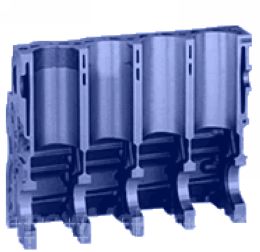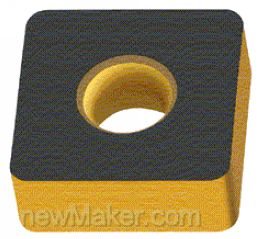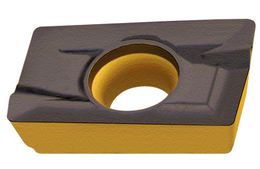Tiger Blade (Tiger·tec) is a new type of hard alloy coated blade for machining cast iron specially developed by Walter Co., Ltd. It is well known that most of the engine's cylinders are made of grey cast iron. Before the advent of the tiger blade, in order to ensure the stability of processing and processing efficiency, many engine manufacturers use ceramic blades for the processing of the cylinder. MAHLE is a manufacturer specializing in motorcycle engines. They also believe that carbide tools are difficult to meet their processing needs. Their cylinder bores are made of grey cast iron like the HT250 (internal grade Niresist) with a bore diameter of 80 mm and a hole length of 150 mm. In the rough machining with a single-sided allowance of 2mm, a dedicated double-edged boring tool and a company's ceramic blade SNGN120712 SL500 (they sometimes use the SNGN120716 blade for controlling the cutting force), the tool life is 70 workpieces. The company that supplies their ceramic blades is the leader in European ceramic blade technology and has considerable competitiveness in ceramic tools. Beginning in 2000, local Walter engineers recommended the tiger blade SNMA120416 WAK10 to them, and they were surprised. Although the cutting speed of 375m per minute of the tiger blade is slightly lower than the cutting speed of 500m per minute of the ceramic blade, since the feed rate is increased from 0.2mm per tooth of the original ceramic blade to 0.27mm per tooth, the processing efficiency is higher than that of the ceramic blade. Slightly higher (1.25%). Under such conditions, the life of the Walter Tiger Blade can also reach 70 pieces steadily, sometimes even 80 pieces. It can be said that it is not inferior in terms of life compared with ceramic blades. At the same time, because the toughness of cemented carbide inserts is higher than that of nitride ceramics, the blade of the tiger has not suffered from the frequent occurrence of edge cracking. MAHLE processors no longer need to carry out frequent and strict monitoring. Since the price of tiger blades is much lower than that of ceramic blades, MAHLE's economic benefits after using tiger blades are very obvious. Before adopting Walter's tiger blades, the annual cost of the blades they used to purchase the process was about 51,000 euros. When the tiger blades were used, the cost of processing the blades for the process had been reduced to 40,700 euros, a drop of more than 20%. . Through this technological revolution, MAHLE not only directly reduced the cost of tool procurement, but also reduced the risk of chipping in the machining process, and reduced the variety of tools (no need for two different tool nose arc radii), The large tool nose arc radius increases the level of surface roughness and reduces the grinding time of the subsequent process. Figure 1 MAHLE engine block Tiger blades generally improve engine manufacturer productivity by using carbide inserts to machine engine cast iron. GKN is one of the world's leading auto parts manufacturers, and they have an engine block production line in their UK plants. The GKN UK plant has long used the SNMA 150616-KR GC3015 insert from a renowned tooling company for roughing of the cylinder, which consumes approximately 5,000 pieces per year. The production of GC3015 is the world leader in the cutting tool industry, and the great achievements in the cutting industry are obvious to all. Before the trial of the Walter Tiger Blade, many tool suppliers tried to replace the GC3015 blade there, and these attempts ended in failure. This situation led to the conclusion that the metal cutting experts at GKN's UK factory even came to the conclusion that the GC3015 blades they used were irreplaceable, and that when Walter experts recommended the tiger blades to them, they did not want to believe in the power of the tiger blades. However, Walter experts fully introduced the successful experience of the Tiger Blade and agreed to follow the cutting test under the conditions of GKN (these conditions are considered to be almost harsh and unimaginable). GKN British experts finally agreed to carry out the cutting test. . The trial was a complete success. When GKN UK used the GC3015 insert, it used a cutting speed of 170m/min and a feed rate of 0.6mm/r. The cutting speed was increased to 285m/min when the Walter Tiger blade was used, and the feed rate was also increased to 0.8. Mm/r, while the depth of cut is still maintained at a level of 5 mm. We know that the usual increase in cutting speed will mean a sharp drop in tool life, such as a 25% increase in cutting speed and a reduction in tool life of about 40% in machined workpieces. Walter's tiger blades, after increasing the cutting parameters in this way, have the same tool life as the GC3015. Although the price of the tiger blade is much more expensive than the GC3015, the GKN UK factory still decided to replace the GC3015 blade with the Walter Tiger Blade due to the increased processing efficiency. Because the processing efficiency of the Walter Tiger Blade has increased to about 224% of the original GC3015, thereby greatly saving processing costs. With the added cost of buying tools, GKN UK will reduce manufacturing costs by £387,300 per year. SN car blade AP milling insert Figure 3 Walter Tiger Blade GCS railway scale can weigh four-axle wagons that meet the requirements of national railway department. It is suitable for quick automatic measuring for large amount goods in port, railway station and mine, factory with special railways. It can also automatically control bulk material in mine, factory, warehouse and wharf. The scale can be designed according to special requirements of users. Electric Train Scales,Wagon Railway Scale,Railway Scale With Static Weighing,Railway Scale SHANDONG JINZHONG SCIENCE & TECHNOLOGY GROUP COMPANY LIMITED , https://www.chinagoldbell.com


1 2 Next page